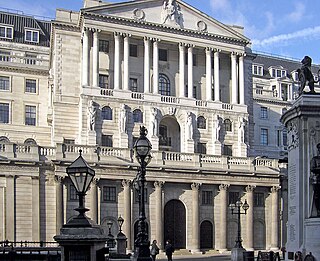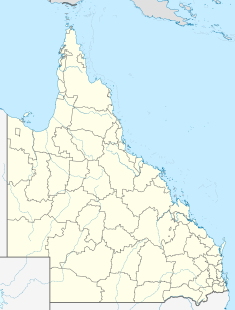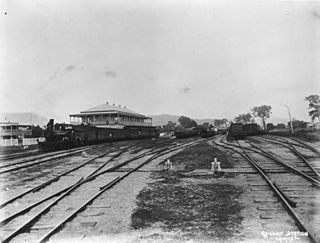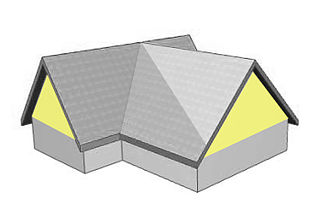
Yungaburra is a town located on the Atherton Tableland in Far North Queensland, Australia, not far from Cairns. In the 2011 census, Yungaburra had a population of 1,116 people.
The Atherton Tableland is a fertile plateau which is part of the Great Dividing Range in Queensland, Australia. The Atherton Tablelands is a diverse region, covering an area of 64,768 square kilometres and home to 45,243 people. The main population centres on the Atherton Tablelands are Mareeba and Atherton. Smaller towns include Malanda, Herberton, Kuranda, Ravenshoe, Millaa Millaa, Chillagoe, Dimbulah, Mt Garnet, Mt Molloy, Tinaroo and Yungaburra.

Curtain Fig Tree is a heritage-listed tree at Curtain Fig Tree Road, Yungaburra, Tablelands Region, Queensland, Australia. It is one of the largest trees in Tropical North Queensland, Australia, and one of the best known attractions on the Atherton Tableland. It was added to the Queensland Heritage Register on 3 December 2009.

The Shire of Eacham was a local government area of Queensland. It was located on the Atherton Tableland, a plateau forming part of the Great Dividing Range west of the city of Cairns. The shire, administered from the town of Malanda, covered an area of 1,126.4 square kilometres (434.9 sq mi), and existed as a local government entity from 1910 until 2008, when it amalgamated with several other councils in the Tableland area to become the Tablelands Region.

Atherton State School Head Teacher's Residence is a heritage-listed school residence at 42 Mable Street, Atherton, Tablelands Region, Queensland, Australia. It was designed and built by the Queensland Department of Public Works in 1913. It is also known as Atherton Provisional School, Enterprise House, and former Principal's Residence. It was added to the Queensland Heritage Register on 21 October 1992.

Jack & Newell General Store is a heritage-listed pair of shops at Grace Street, Herberton, Tablelands Region, Queensland, Australia. They were built c. 1882 and in 1895. It was added to the Queensland Heritage Register on 22 April 1993.

Malanda Falls Swimming Pool is a heritage-listed swimming pool at Malanda Falls Park, Malanda, Tablelands Region, Queensland, Australia. It was built in 1906 onwards. It was added to the Queensland Heritage Register on 5 February 2010.

Lake Eacham Hotel is a heritage-listed hotel at 6-8 Kehoe Place, Yungaburra, Tablelands Region, Queensland, Australia. It was built in 1910 by Side Brothers. It was added to the Queensland Heritage Register on 21 October 1992.

Cairns Plywood Pty Ltd Sawmill Complex is a heritage-listed sawmill at 25 - 33 Eacham Road, Yungaburra, Tablelands Region, Queensland, Australia. It was built from 1910 to 1980s. It is also known as Cairns Plywood Limited, Eacham Sawmills, and Williamson Brothers Sawmill. It was added to the Queensland Heritage Register on 21 October 1992.

St Patrick's Catholic Church is a heritage-listed church at 1 Penda Street, Yungaburra, Tablelands Region, Queensland, Australia. It was built from 1914 to 1930s. It is also known as Our Lady of Ransom. The church is part of the Roman Catholic Diocese of Cairns. It was added to the Queensland Heritage Register on 21 October 1992.
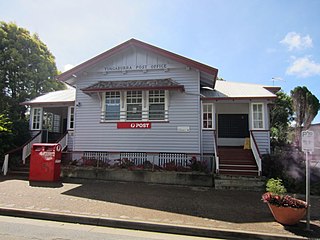
Yungaburra Post Office is a heritage-listed post office at 15-17 Cedar Street, Yungaburra, Tablelands Region, Queensland, Australia. It was built in 1926. It was added to the Queensland Heritage Register on 21 October 1992.

Yungaburra Court House is a heritage-listed courthouse at 6 - 10 Cedar Street, Yungaburra, Tablelands Region, Queensland, Australia. It was built from 1909 to 1921. It is also known as Court of Petty Sessions. It was added to the Queensland Heritage Register on 21 October 1992.

Eden House Restaurant is a heritage-listed detached house at 20 Gillies Highway, Yungaburra, Tablelands Region, Queensland, Australia. It was built c. 1914. It is also known as Nibbles Tea House. It was added to the Queensland Heritage Register on 21 October 1992.

Yungaburra Community Centre is a heritage-listed community hall at 19 Cedar Street, Yungaburra, Tablelands Region, Queensland, Australia. It was built from 1910 to c. 1926. It is also known as Tivoli picture theatre, Williams Estate Hall, and Yungaburra Hall. It was added to the Queensland Heritage Register on 21 October 1992.

Barbers's Shop is a heritage-listed former barber shop at 34 Cedar Street, Yungaburra, Tablelands Region, Queensland, Australia. It was built c. 1925. It was also known as Burra Inn Restaurant and The Workshop. It was added to the Queensland Heritage Register on 21 October 1992.

Allumbah is a heritage-listed detached house at 7 Mulgrave Road, Yungaburra, Tablelands Region, Queensland, Australia. It was built c. 1926. It is also known as Artist's Gallery. It was added to the Queensland Heritage Register on 21 October 1992.

Williams' House is a heritage-listed detached house at 16-20 Cedar Street, Yungaburra, Tablelands Region, Queensland, Australia. It was built from c. 1915 to the 1940s. It was added to the Queensland Heritage Register on 21 October 1992.

Billy Madrid's House is a heritage-listed shop at 32 Cedar Street, Yungaburra, Tablelands Region, Queensland, Australia. It was built c. 1925. It is also known as Special Glass Company Shop, T.A.B. Agency, and Tailor's shop. It was added to the Queensland Heritage Register on 21 October 1992.

7-9 Cedar Street, Yungaburra is a heritage-listed pair of shops at 7-9 Cedar Street, Yungaburra, Tablelands Region, Queensland, Australia. They were built in the 1920s. They were added to the Queensland Heritage Register on 15 March 1996.

Butchers Shop is a heritage-listed butcher shop at 2 Kehoe Place, Yungaburra, Tablelands Region, Queensland, Australia. It was built c. 1922. It was added to the Queensland Heritage Register on 21 October 1992.

